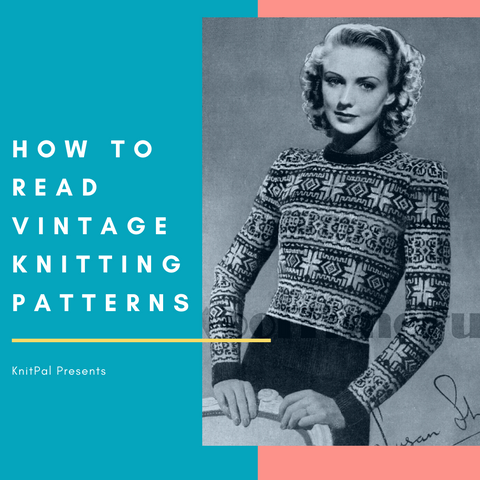
How To Read Vintage Knitting Patterns
Love the vintage look? Or maybe you found a vintage pattern that you just have to make? Reading vintage knitting patterns can prove tricky the further back in time you go. In this post we’ll look at the names that were used for different stitches in vintage patterns as well as the tools and yarn that you can use for different patterns.

Vintage knitting pattern terms and what they mean
When you start reading a vintage pattern you’ll probably notice a few things, including the strange names and terms given to some stitches. While “newer” vintage patterns will use knit and purl, many older patterns use different terms.
![]() Knit stitches
Knit stitches
The knit stitch may be called “knit”, “k” or “plain” in vintage knitting patterns. Therefore, when told by the pattern to “knit/make a plain row”, for example, you simply need to knit a row using only knit stitches. Knitting through the back loop may be called “twist” or “twist stitch”.
![]() Purl stitches
Purl stitches
For purl stitches; pearl, seam, and rib-stitch can be used. When working only through the back loop, “twist” or “twist stitch” may be used, the same as when knitting through the back loop.
![]() Slip stitches may be called “s”, “sl” or “pass a stitch”. “Pass a stitch” in vintage patterns, however may both mean “to pass a stitch over” as it does in modern patterns, or it may mean “slip the stitch”. It’s therefore very important to read the pattern carefully before making a slip stitch.
Slip stitches may be called “s”, “sl” or “pass a stitch”. “Pass a stitch” in vintage patterns, however may both mean “to pass a stitch over” as it does in modern patterns, or it may mean “slip the stitch”. It’s therefore very important to read the pattern carefully before making a slip stitch.
There are many terms meaning “yarn over” in vintage patterns. These terms include the following, according to Roving Crafters:
- Over
- O (in this instance, “O2” would refer to a double yarn over)
- Cast-over
- “Bring yarn forward” or “bring the thread forward”
- Make 1 (If you’re working with a Victorian or Edwardian pattern, use a yarn over and not a modern “make 1”)
- Throw yarn over
- Loop stitch
![]() Decreases may be written as “narrow” or simply “n”. In this instance, to “narrow” would be to knit 2 stitches together. In modern abbreviations, this is usually written as k2tog.
Decreases may be written as “narrow” or simply “n”. In this instance, to “narrow” would be to knit 2 stitches together. In modern abbreviations, this is usually written as k2tog.
![]() Increases, on the other hand, are called “to widen”, “w” or “widen”. This seems to always mean “make 1” in the modern sense.
Increases, on the other hand, are called “to widen”, “w” or “widen”. This seems to always mean “make 1” in the modern sense.
Knitting rows and ribbing as well as miscellaneous stitches
As we’ve seen, reading vintage knitting patterns can take a bit of creativity sometimes – for example to know that “decrease”, “narrow”, and “k2tog” means exactly the same thing!
The terms used for knitting different types of rows are also sometimes different from the terms that are used in modern patterns.
For example, according to My Knitting Book (1843):
- “A turn” means to knit two rows using the same stitch (not necessarily the knit stitch).
- “To turn” means to change from one stitch to another, for example from a knit stitch to a purl stitch.
- “A Row”, like in modern knitting, also refers to knitting all the stitches on the needle once (that’s to say, working once from one side to the other). “A round” is used when knitting on DPNs, and working in the round.
- “A plain row” means to knit a row using the knit stitch.
- “To pearl a row” means to knit a row using the purl stitch.
- “To rib” means to knit alternate rows of knit and purl stitches. This seems to mean that a “rib” (in some instances at least) also refer to what we’d call stockinette.
- “Ribbing” is the same as in modern knitting. However, it’s rarely ever stated which ribbing to work. The most basic one is alternating knitting 2 stitches and purling 2 stitches for the amount of rows that are required. Make sure that you always knit and always purl the same stitches in every row to keep the pattern consistent.
- A “third pin” is often called for in patterns that make use of cabling details. This refers to a third knitting needle or cable needle (cable needles are a quite modern invention).
![]() Tips for knitting vintage patterns
Tips for knitting vintage patterns
- When knitting a vintage pattern, always make sure of your gauge. Patterns before the 1950s all used 100% wool yarn (as synthetics was a later invention) and you will need to make sure that the yarn you’ve chosen correspond as closely as possible to that which was used in the original pattern. Although mostly wool is used, you may find some cotton or silk patterns as well.
- Rather than looking at the clothing sizes, look at the measurements given for the garments. Clothing sizes have come to change quite drastically over the decades and the last thing you want is for all your hard work to go to waste because the pattern is a few inches too small!
- Always read the pattern through before starting to make sure that you know what the terminology means.
- If the pattern is short, you can “rewrite” the pattern in the modern terms. However, you can also simply have a key to the stitch names by creating a list with the stitches used in the pattern and their modern names.
- To see how to do the math to change a vintage knitting pattern’s size, see Knitting Unplugged’s “Tips to Adapting Vintage Knitting Patterns” by Valerie Gross.
More vintage knitting pattern resources
Vintage Knitting Pattern Archive by the Sunny Stitcher
Victorian Knitting Manuals on the Internet Archive
My Knitting Book by Miss Lambert

